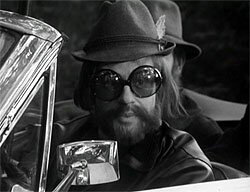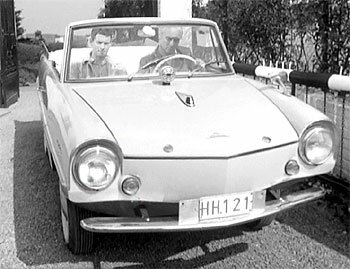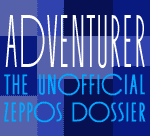|
Considering the obvious success of
the original Kapitein Zeppos serial, one could be forgiven for
wondering why it was four years before a sequel was produced and
transmitted. The answer is a little unclear, but it's worth bearing
in mind that the BRT could only afford to produce just one 16-week
youth series per year. Had the producers immediately set to work on
another Zeppos serial, it would impact on the variety of the youth
strand - undoubtedly one of its strengths. For whatever reason then,
it was not until 1968 that a return visit to the Mill Cottage was
attempted.
 This time, unlike the first series,
which comprised one long story, the new series would be split in
two, with each new adventure lasting eight weeks. These two serials
were entitled De Eglantier (The Wild Rose) and Tweng
(the name of a peace organisation). For the sake of convenience,
here at Adventurer, these serials are consistently referred
to as Series Two (De Eglantier) and Series Three (Tweng).
Despite this, the two serials can also be viewed as one series, as
they were produced directly after each other and shared the same
production crew. They also ran for 16 consecutive weeks on
broadcast. This time, unlike the first series,
which comprised one long story, the new series would be split in
two, with each new adventure lasting eight weeks. These two serials
were entitled De Eglantier (The Wild Rose) and Tweng
(the name of a peace organisation). For the sake of convenience,
here at Adventurer, these serials are consistently referred
to as Series Two (De Eglantier) and Series Three (Tweng).
Despite this, the two serials can also be viewed as one series, as
they were produced directly after each other and shared the same
production crew. They also ran for 16 consecutive weeks on
broadcast.
As with the earlier Kapitein Zeppos
series (1964), the stories were written by Lode de Groof and
produced by Rik Van den Abbeele with realisation by Bert Struys. One
notable change was that original series director, Senne Rouffaer,
stepped aside from the behind-the-scenes role, replaced by Jef
Demedts. The central cast were engaged once more to reprise their
original roles - notably Senne Rouffaer as Captain Zeppos, Raymond
Bossaerts as Ben, Cyriel Van Gent as Gust and Henriette Cabanier as
Ben's grandmother. Additionally, Vera Veroft who played Ariane Despinal in
the 1964 series, returned as the same character, now married to
Zeppos. New additions to the cast were the villainous Clovis (Alex
Cassiers), Hugo and Frank Brems (played respectively by Jackie Morel
and Senne Rouffaer's son, Bruno) and the enigmatic Aunt Cara,
portrayed by Cara Van Wersch. The latter would also go on to feature
in Tweng.
 The series seemed to have undergone
something of a stylistic metamorphosis in the four years off screen,
with De Eglantier feeling a little quirkier than the original
serial, influenced perhaps by the hugely successful British
television series, The Avengers. Tweng would go
further down this path, but more of that on the
Series Three
page. Whereas Belderbos featured straightforward villains and
characters, those in De Eglantier were a little comic-strip,
slightly bizarre. Likewise, the plot - involving a painting, "De
Eglantier", that a group of unscrupulous strangers are plotting to
steal - is somewhat more
tongue-in-cheek and playful than its forebear. Additionally, Zeppos
now has an amphibious car - an
Amphicar - which is used to
great effect, taking to the waters of Belgium's network of canals
with Senne Rouffaer regularly at the wheel. The car would become an
integral part of the public's memory of the series. In effect, it
was to Captain Zeppos what the vintage green Bentley was to John
Steed - inextricably linked with the character. The series seemed to have undergone
something of a stylistic metamorphosis in the four years off screen,
with De Eglantier feeling a little quirkier than the original
serial, influenced perhaps by the hugely successful British
television series, The Avengers. Tweng would go
further down this path, but more of that on the
Series Three
page. Whereas Belderbos featured straightforward villains and
characters, those in De Eglantier were a little comic-strip,
slightly bizarre. Likewise, the plot - involving a painting, "De
Eglantier", that a group of unscrupulous strangers are plotting to
steal - is somewhat more
tongue-in-cheek and playful than its forebear. Additionally, Zeppos
now has an amphibious car - an
Amphicar - which is used to
great effect, taking to the waters of Belgium's network of canals
with Senne Rouffaer regularly at the wheel. The car would become an
integral part of the public's memory of the series. In effect, it
was to Captain Zeppos what the vintage green Bentley was to John
Steed - inextricably linked with the character.
As with the first series, breathtaking
location work continued to be central to the production, with the
camera crew visiting Ghent (in Dutch: Gent), a vibrant town in
Flanders that dates from medieval times. The scenes around Ben's new
town apartment were shot in this area and in a sequence shot for
Episode Four, Senne Rouffaer drove the Amphicar along the canal into
the centre of the town.
Sadly, the second and third
Kapitein Zeppos serials were never dubbed (or subtitled) into
English, which for English-speaking fans is something of a shame.
The first series had been successful in the UK and had inspired a
translation of de Groof's novelisation. However, in the late 1960s,
when these serials were made, the BBC were gearing up for colour
transmissions on both its channels, so it's fair to suppose that the
fact that Kapitein Zeppos was being made in black and white
may well have counted against it. Additionally, the BBC's popular
children's strand Tales From Europe (occasionally going under
the banner of Tales From Overseas) was drawing to a close,
finishing in May 1969, so the demand for such programming was on the
decline at the BBC. Sadly, there were many British children who
would have been delighted to catch up with the new adventures of the
Captain, but it wasn't to be.
However, in Belgium, this was - quite
rightly - of little consequence, with the serial playing to
enthusiastic audiences. Again, Louis de Groof adapted his serial as
a novel - and De Eglantier itself enjoyed reruns on the BRT
(later VRT) in 1975, 1985 and 2004. The most recent transmission
formed part of the VRT's 50th Anniversary celebrations.
|
